August 9 - 15, 2020: Issue 461
Stamp Collecting Month 2020: Wildlife Recovery
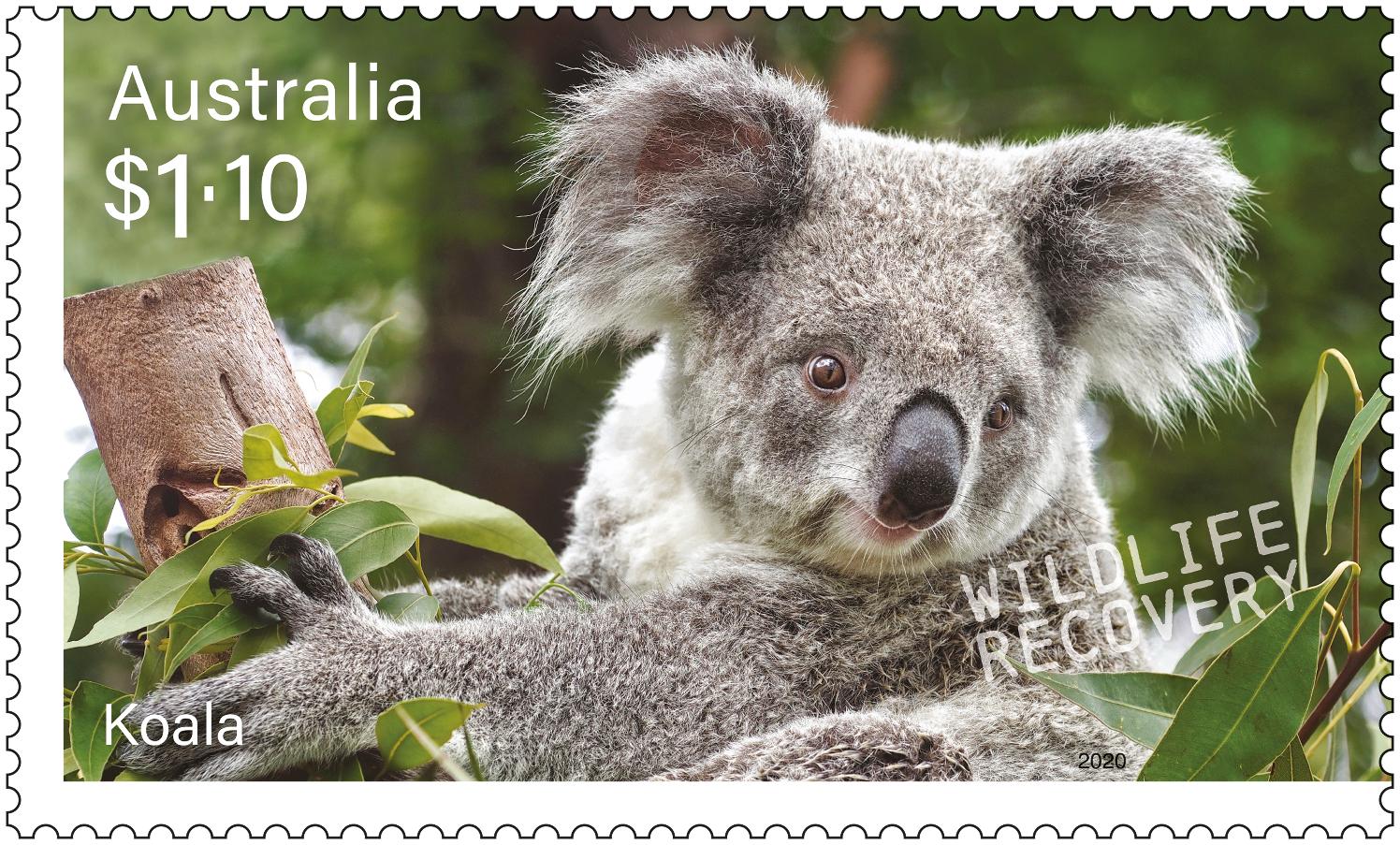
Australia Post Encourages Future Wildlife Champions With Stamp Collecting Month
August 4, 2020
Australia Post is encouraging young Australians to become passionate about Australian wildlife this August, with the Stamp Collecting Month theme ‘Wildlife Recovery’.
Past themes have included; In the Garden, Things that Sting, Our Solar System and more.
To mark the start of the month, six stamps highlighting some of Australia’s most vulnerable native species will be available from today. The featured animals have been selected from those recently identified by the federal government’s Wildlife and Threatened Species Bushfire Recovery Expert Panel as in need of immediate conservation management.
Australia Post Executive General Manager Community and Consumer Nicole Sheffield said that this year’s theme aims to inspire school students across the country to learn more about Australia’s wildlife and take an active role in protecting them for the future.
“We want this year’s Stamp Collecting Month to encourage a lifelong passion for Australian wildlife. Alongside the wonderful stamps released today, the teaching resources we’ve developed will encourage education, literacy and a sharing of knowledge about the threats that our wildlife face,” said Ms Sheffield.
Australia’s Threatened Species Commissioner Dr Sally Box, said that the recent bushfire tragedies highlighted the dangers facing Australian wildlife and is encouraging schools and the broader community to get involved.
“The 2019–20 bushfires had a devastating impact on Australian wildlife, and it’s great to see Stamp Collecting Month reminding people how precious our native animals are.
“We can all play a role in caring for our wildlife, and Stamp Collecting Month is educating and inspiring young Aussies to become our future wildlife conservationists.”
The stamps and associated products will be available from today in participating Post Offices, via mail order on 1800 331 794, and online at auspost.com.au/stamps while stocks last.
Visit the Australia Post Collectables website auspostcollectables.com.au for more information on Australian stamp issues.
Education resources are available online at auspost.com.au/scm and include information on each species featured, videos, curriculum-linked lesson plans and literacy activities for primary school students. Visit australiapostcollectables.com.au/stamp-collecting-month This website explores a range of topics related to wildlife conservation and the Australia Post Wildlife Recovery stamp issue. It also contains videos, fun activities, teaching resources and more.
Wildlife Recover Stamps 2020
$1.10 Bathurst Copper Butterfly
One of Australia’s rarest butterflies, the Bathurst Copper Butterfly (Paralucia spinifera), also known as the Purple Copper Butterfly and the Bathurst Copper, is endemic to the Central Tablelands of New South Wales, found in around 30 locations between Bathurst and Hartley, in an area comprising less than 30 hectares. This species occurs mainly in eucalypt woodlands above 900 metres. This small butterfly has a thick body and a wingspan of 20–30 millimetres. The upper side of its wings are copper to black with a purple, green or bronze iridescence, and underneath it has a subtle brown, black and grey patterning. Its flight is weak and erratic, always in close proximity to foliage, which restricts the butterfly's range.
The Bathurst Copper Butterfly has a mutually beneficial relationship with an attendant ant species (Anonychomyrma itinerans) that occupies the same host plant, a blackthorn, on which the butterfly exclusively feeds. The female lays her eggs on or near the ants’ nests, and when they hatch the ants marshal the larvae into their nests during the day, where they are protected, and onto the blackthorn to feed in the evening. In return, the ants enjoy the sweet dew produced by a gland on the backs of larvae. The larvae later pupate in the ants’ nests.
The Bathurst Copper Butterfly is listed as vulnerable in the national EPBC Act and endangered in the state’s Threatened Species Conservation Act. First described in 1978, this butterfly is at risk due to its limited distribution, degraded habitat and land use (clearing, grazing, spraying, weed invasion), and illegal collection. Its habitat requirements and weak flight restrict its distribution.
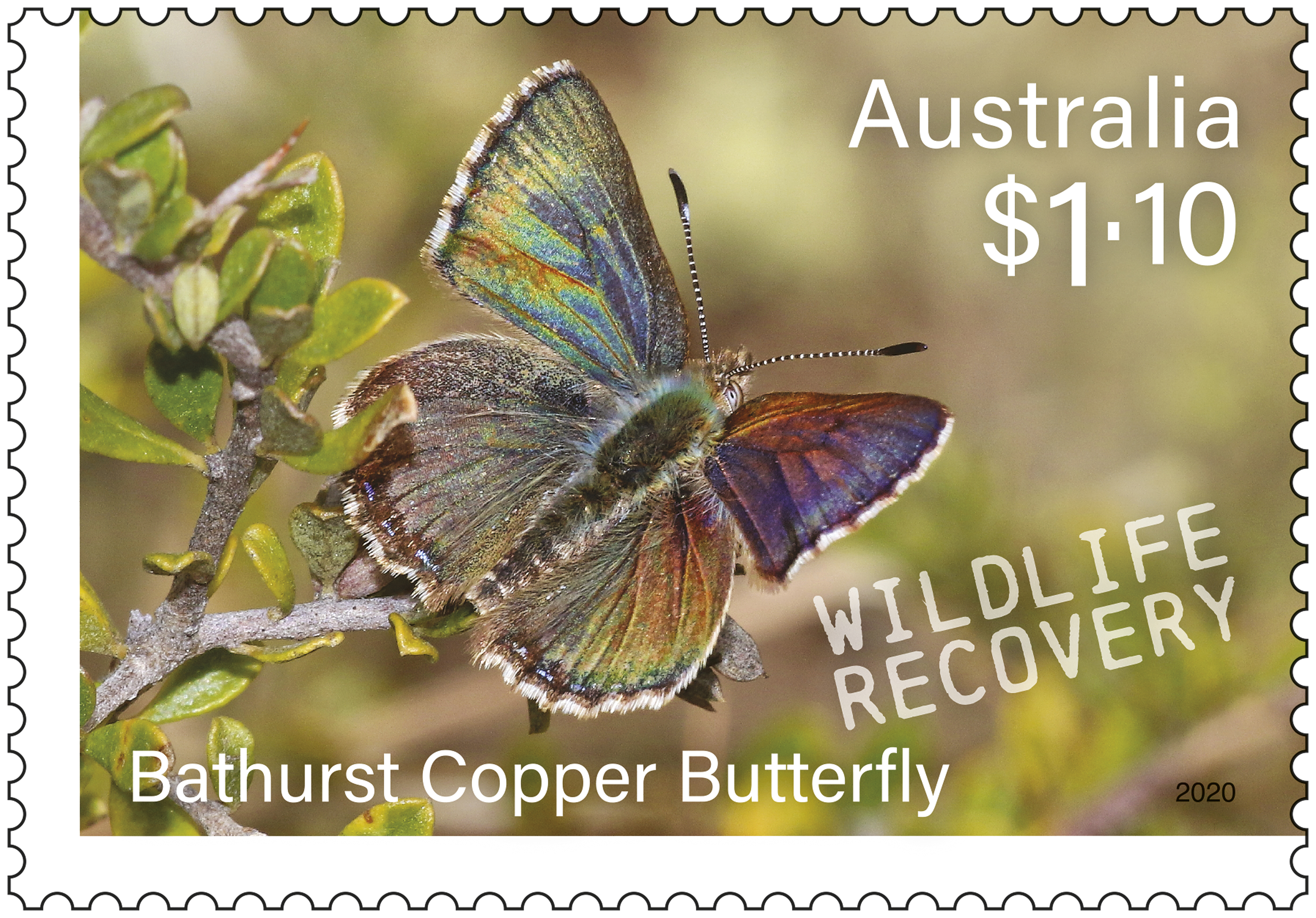
$1.10 Davies’ Tree Frog
The Davies’ Tree Frog (Litoria daviesae) is a medium-sized frog, with females growing to 6.5 centimetres in length and males to around 5.3 centimetres. The upper part of this frog can vary in colour, but is mainly golden brown to dark brown with mottled patches. It has a broad green band running from its snout to its shoulder, with green also along its outer thighs. It has a narrow dark stripe from its nostrils through its eyes that broadens and breaks up along its sides, and a fine white line along its upper lip. The Davies’ Tree Frog occurs in a number of small populations on the eastern escarpment of the Great Dividing Range and the adjacent tablelands, between Carrai Plateau and Barrington Tops in New South Wales. It is found at elevations above 400 metres in forest, shrubland and wetland areas, where it is associated with clean upland streams with well-vegetated banks. Adults remain close to water, and the larvae develop in streams.
This endemic frog is listed as vulnerable in New South Wales, as well as on the IUCN Red List. It is threatened by forest clearance for agriculture, and some streams have been stocked with exotic fish species, which are thought to feed on its tadpoles. The restricted range of the Davies’ Tree Frog increases its vulnerability, a fact highlighted by the recent extensive bushfires.
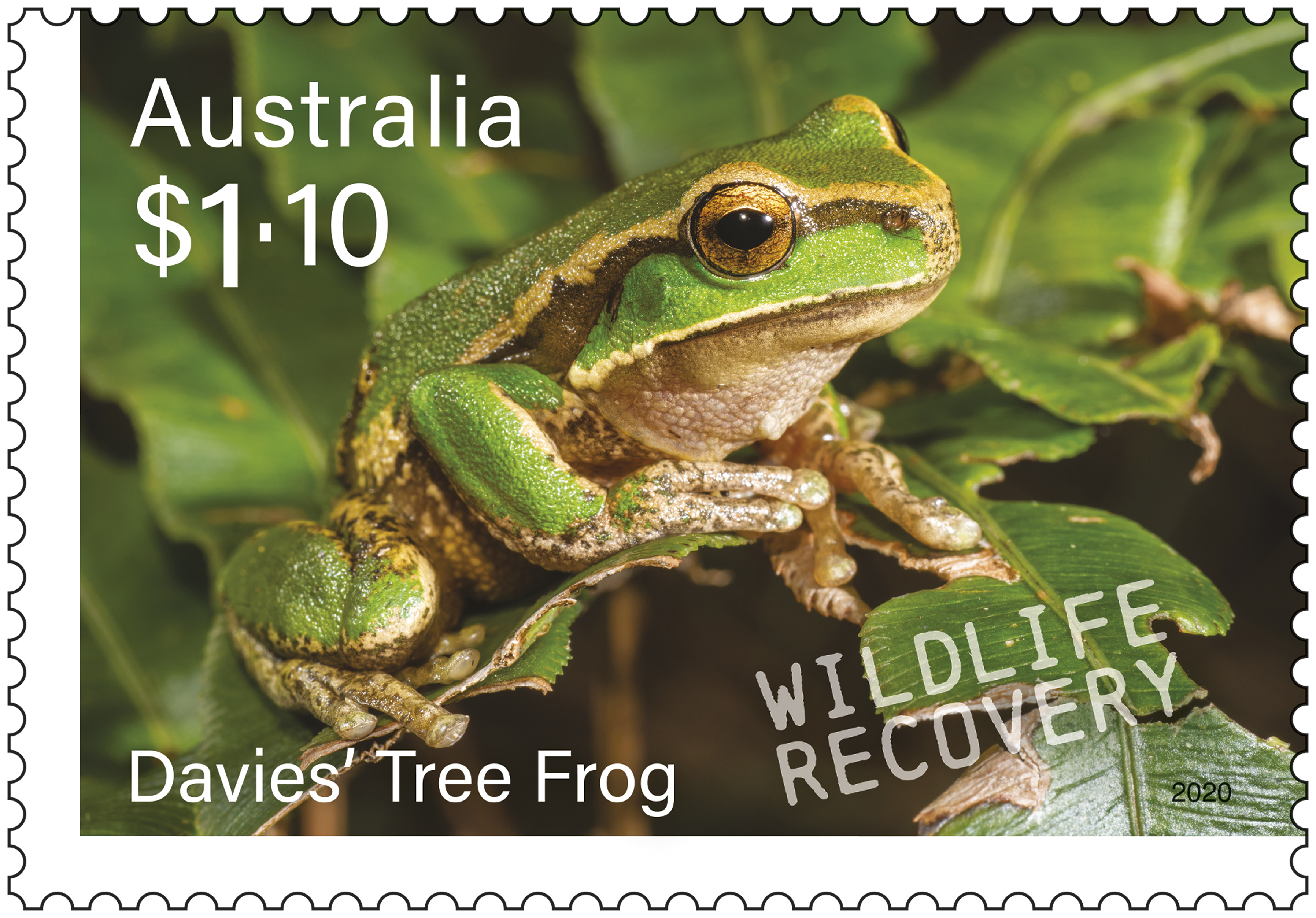
$1.10 Kangaroo Island Dunnart
The Kangaroo Island Dunnart (Sminthopsis griseoventer aitkeni) is a small marsupial with a pointed snout and wide, square-shaped ears. Weighing around 25 grams, it is nocturnal and insectivorous. Little is known about the behaviour and lifecycle of this dunnart, which is the Kangaroo Island’s only endemic mammal. It was classified as critically endangered by the IUCN in 2008, when it became clear that its small population was highly localised on the western end of Kangaroo Island. Dunnarts have been found within the remnant low mallee and low woodland vegetation habitats of the Flinders Chase National Park and on privately owned conservation land. Numbering between 300 and 500 individuals before the 2019–20 bushfires, which burnt approximately one-third of the island, the dunnart has since been named by the federal government as one of Australia’s most at-risk species.
The main identified threats to the Kangaroo Island Dunnart are habitat loss through extensive and high-intensity bushfires, land clearing and Phytophthora cinnamomi dieback (a water mould that causes root rot), predation from invasive species such as feral cats, and the potential loss of genetic diversity through isolation of populations. Over the past two years, conservation efforts to save the species from extinction have helped ecologists better understand how to protect the dunnart and its habitat from threats. Immediately following the bushfires, Kangaroo Island Land for Wildlife in partnership with the Australian Wildlife Conservancy and private landholders completed a 14-hectare emergency feral-animal-proof fence around a known Kangaroo Island Dunnart population. This builds on the monitoring and threat reduction efforts already in place for this critically endangered species. A feral cat eradication program aims to rid Kangaroo Island of feral cats by 2030, further protecting the dunnart and other threatened wildlife species that call the island home.
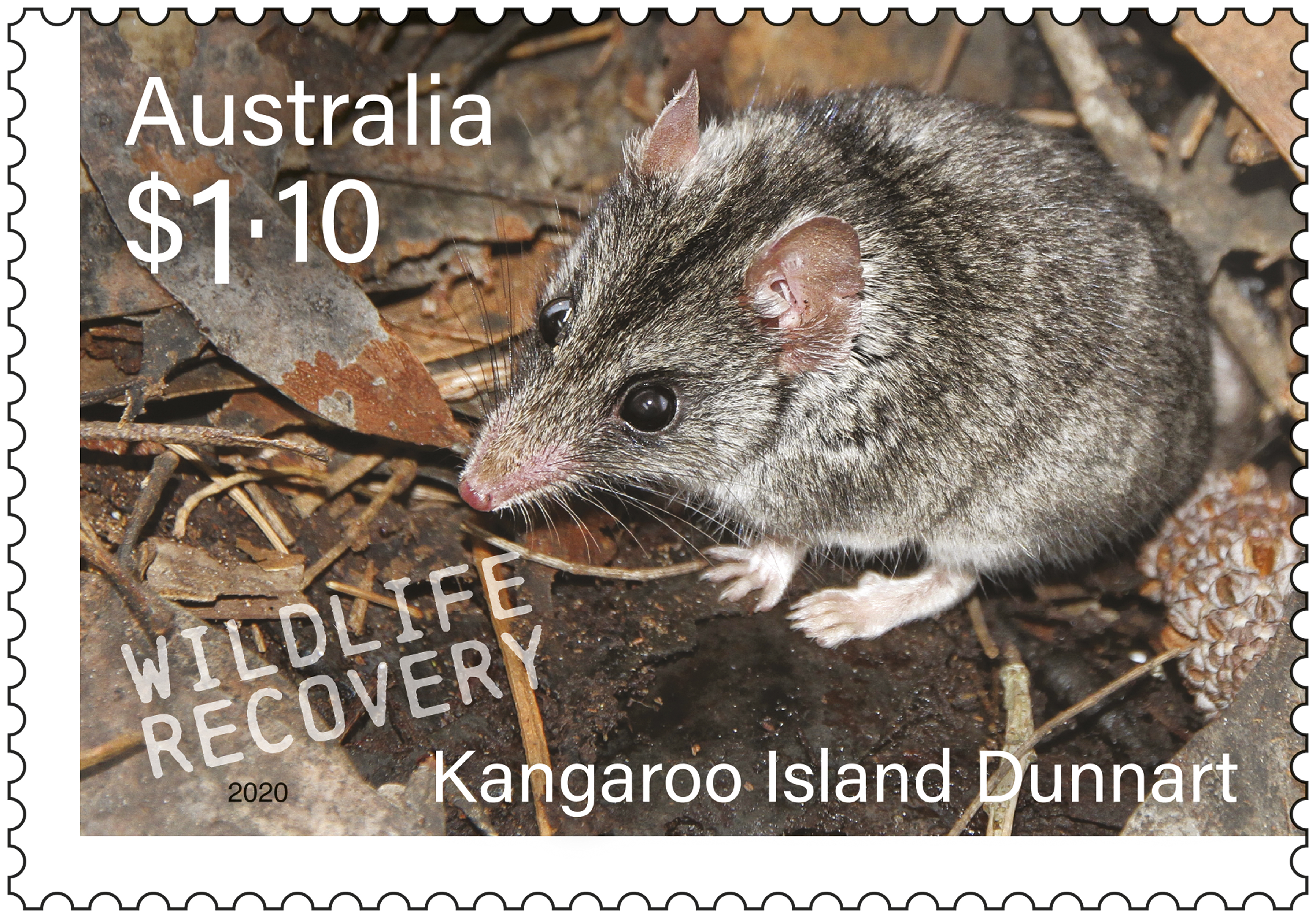
$1.10 Regent Honeyeater
The Regent Honeyeater (Anthochaera phrygia) is a striking bird, with a black head and neck, lemon-flecked back and breast, and deep yellow wing patches and edge to its tail. This gregarious honeyeater traditionally occupied eucalypt woodlands in eastern Australia from Rockhampton to Adelaide, but its territory has been significantly reduced through the loss and degradation of its habitat and competition from aggressive species such as the Noisy Miner. This honeyeater is now present only in New South Wales and Victoria, where it is especially associated with the western slopes of the Great Dividing Range, an area affected by the bushfires.
It is classified as critically endangered on national conservation lists, as well as on the IUCN Red List. Prior to the bushfires it was thought that its number could be as low as 400 in the wild. Conservation interventions have included captive breeding and release programs since the mid-1990s, which have had mixed results, habitat protection and restoration, and control measures of the competitive Noisy Miner.
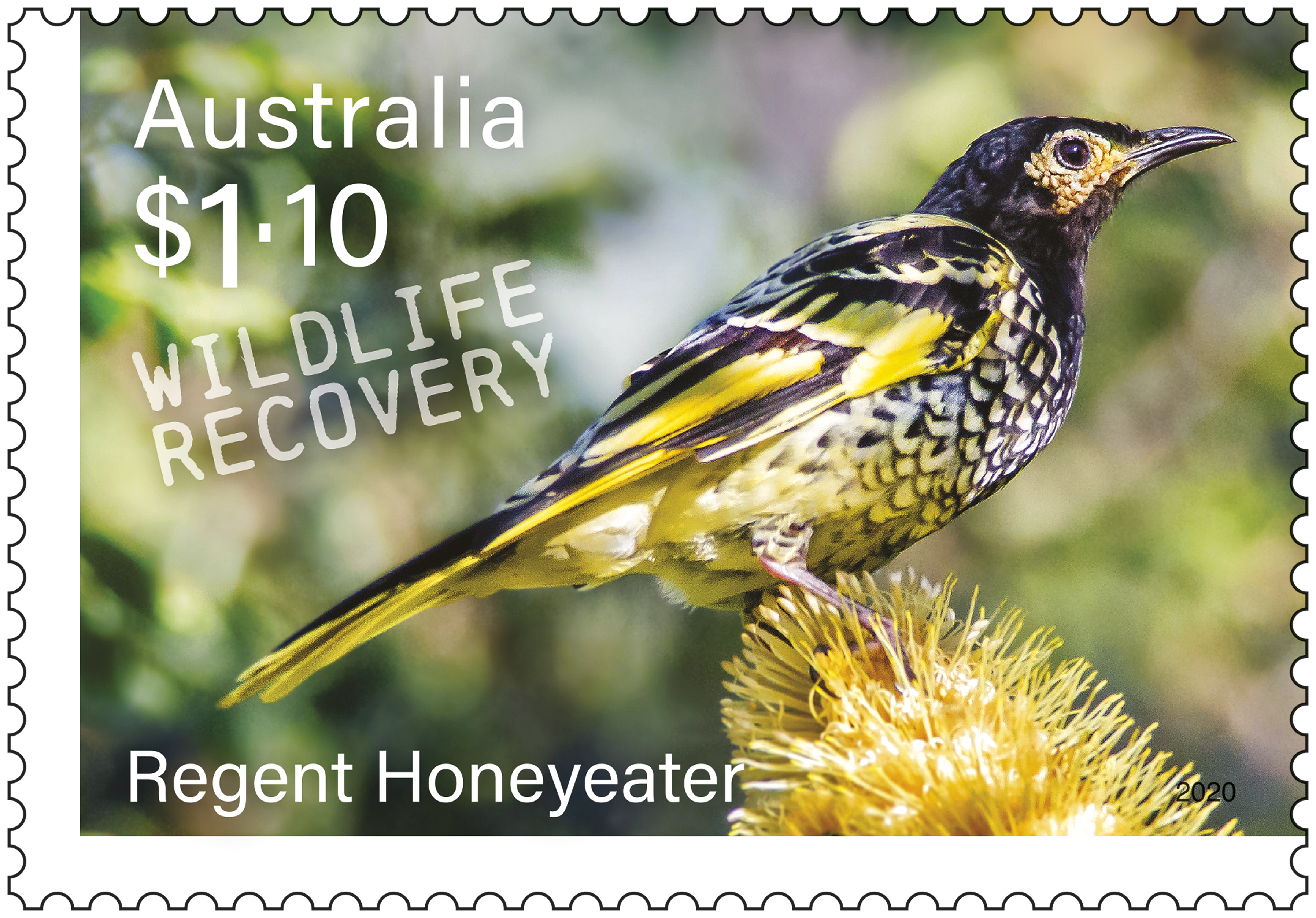
$1.10 Blue Mountains Water Skink
A medium-sized semi-aquatic lizard, the adult Blue Mountains Water Skink (Eulamprus leuraensis) is around 20 centimetres in total length, with its tail being around 12 centimetres. It is predominantly coloured dark brown to black, with pale to strong-yellow stripe markings from head to tail, with a dark section running the length of its back. Its dark sides and legs are marked with blotches and spots of yellow and bronze.
Found in high-elevation peat swamps in the middle and upper Blue Mountains, this skink is endemic to this region west of Sydney, and occurs from Newnes Plateau in the north-west to just south of Hazelbrook in the south-east. Prior to the bushfires, which swept through much of the Blue Mountains, it had been known to occur at around 70 wet sites. The Blue Mountains Water Skink is listed as endangered in national and state legislation, and in 2017 it was added to the IUCN Red List. Its main threats have been identified as longwall coalmining in the Newnes Plateau, which affects groundwater resources; bushfires, including hazard-reduction fires; and land use, including urbanisation, grazing and recreational activities.
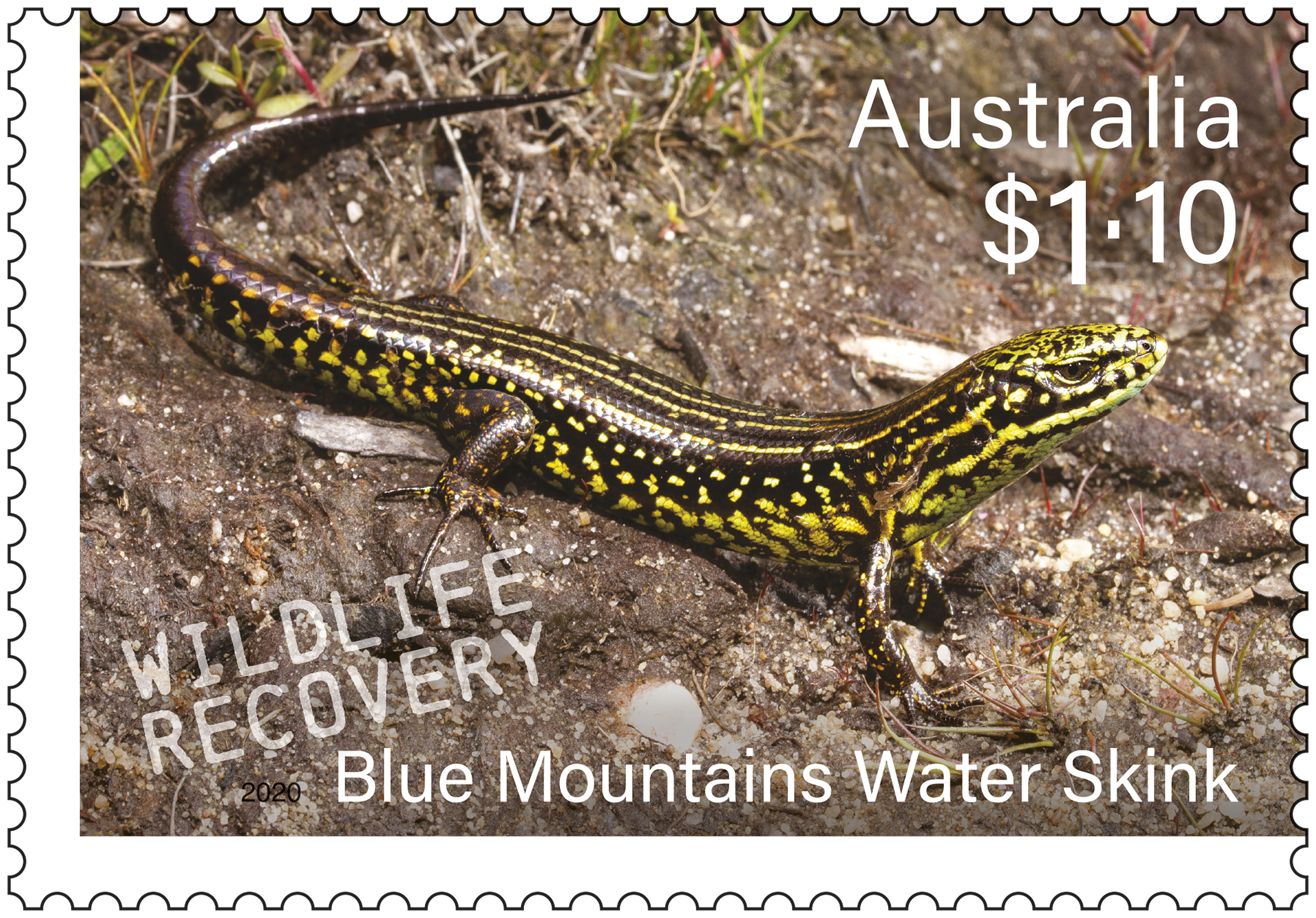
$1.10 Koala
The Koala (Phascolarctos cinereus) is one of Australia’s most distinctive and loved native animals. This tree-dwelling marsupial is highly recognisable, with its compact, tailless body coloured silver-grey to brown, its large tufted round ears, and its flat spoon-like nose. The body length of the adult Koala is 60–85 centimetres, and it can weigh up to around 15 kilograms; those in the northern part of its broad range tend to be smaller than those in the south. The Koala occurs naturally in eucalypt-dominated areas from Queensland down the eastern seaboard to Victoria. Populations have also been introduced onto some islands along that coast, as well as onto Kangaroo Island and to the Murray River and Adelaide regions in South Australia. The herbivorous Koala is a specialist feeder, almost exclusively consuming eucalypt leaves.
The Koala is listed as vulnerable in Queensland, New South Wales and Australian Capital Territory legislation, and also on the IUCN Red List. While it has an extensive range, its numbers have decreased significantly since European settlement and they continue to decrease. While estimates of the number of mature adults vary, and density differs between the various populations, they are thought to number around 300,000 across the country. The threats faced by Koalas arise from urbanisation and land use, which reduce and fragment habitat; transport corridors, which expose the Koala to fast-moving vehicles; climate change, which results in drought and bushfires; and disease. Many mainland populations are affected by chlamydia, to which koalas are susceptible, causing blindness, urinary and reproductive problems, and even death. The Kangaroo Island population (confined to the Flinders Chase National Park) is one of the few wild populations free of this disease. It is estimated that half of these Koalas were lost in the recent bushfires. In many areas during and after the bushfires, Koalas were rescued and evacuated to triage centres and shelters, and as they have been remediated they’ve been released into unaffected areas with plentiful eucalyptus.
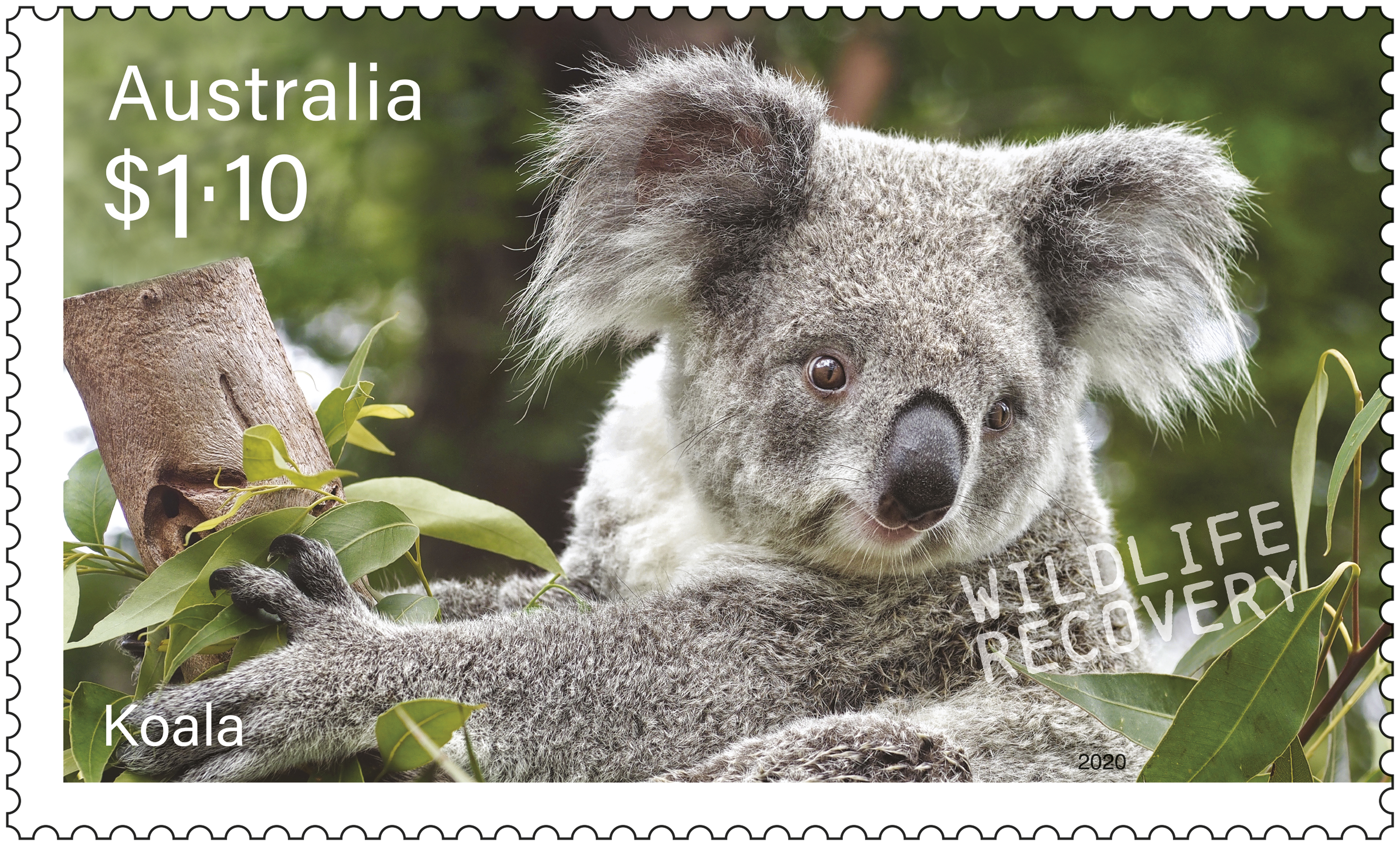
Philately - Stamp Collecting
Stamp collecting is generally accepted as one of the areas that make up the wider subject of philately, which is the study of stamps. A philatelist may, but does not have to, collect stamps. It is not uncommon for the term philatelist to be used to mean a stamp collector. Many casual stamp collectors accumulate stamps for sheer enjoyment and relaxation without worrying about the tiny details. The creation of a large or comprehensive collection, however, generally requires some philatelic knowledge and will usually contain areas of philatelic studies.
The word "philately" is the English transliteration of the French "philatélie", coined by Georges Herpin in 1864. Mr Herpin stated that stamps had been collected and studied for the previous six or seven years and a better name was required for the new hobby than timbromanie (roughly "stamp quest"), which was disliked. The alternative terms "timbromania", "timbrophily" and "timbrology" gradually fell out of use as philately gained acceptance during the 1860s. He took the Greek root word phil(o), meaning "an attraction or affinity for something", and ateleia, meaning "exempt from duties and taxes" to form "philatelie".
Postage stamps are often collected for their historical value and geographical aspects and also for the many subjects depicted on them, ranging from ships, horses, and birds to kings, queens and presidents.
Sales of postage stamps are an important source of income for some countries whose stamp issues may exceed their postal needs, but have designs that appeal to many stamp collectors.
Some scholars state that John Bourke, Receiver General of Stamp Dues in Ireland, was the first collector. In 1774 he assembled a book of the existing embossed revenue stamps, ranging in value from 6 pounds to half a penny, as well as the hand stamped charge marks that were used with them. His collection is preserved in the Royal Irish Academy, Dublin.
Postage stamp collecting began at the same time that stamps were first issued, and by 1860 thousands of collectors and stamp dealers were appearing around the world as this new study and hobby spread across Europe, European colonies, the United States and other parts of the world.
The first postage stamp, the Penny Black, was issued by Britain in May 1840 and pictured a young Queen Victoria. It was produced without perforations (imperforate) and consequently had to be cut from the sheet with scissors in order to be used. While unused examples of the Penny Black are quite scarce, used examples are quite common, and may be purchased for $20 to $200, depending upon condition.
.jpg?timestamp=1596580988097)
The Penny Black: Large mint block of the Penny Black; Royal Mail; portrait engraving by Charles and Frederick Heath, after a sketch by Henry Courbould, after William Wyon. Mint block of thirty Penny Black stamps from the Phillips Collection, Volume III: 1d black plate 11; Postal Museum, London.
People started to collect stamps almost immediately. One of the earliest and most notable was John Edward Gray. In 1862, Gray stated that he "began to collect postage stamps shortly after the system was established and before it had become a rage".
Female stamp collectors date from the earliest days of postage stamp collecting. One of the earliest was Adelaide Lucy Fenton who wrote articles in the 1860s for the journal The Philatelist under the name Herbert Camoens.
As the hobby and study of stamps began to grow, stamp albums and stamp related literature began to surface, and by the early 1880s publishers like Stanley Gibbons made a business out of this hobby.
Children and teenagers were early collectors of stamps in the 1860s and 1870s. Many adults dismissed it as a childish pursuit but later many of those same collectors, as adults, began to systematically study the available postage stamps and publish books about them. Some stamps, such as the triangular issues of the Cape of Good Hope, have become legendary.
By the early 2000's stamp collecting was seen to be in decline as the digital world surpassed traditional hobbies even though by 2013, The Wall Street Journal estimated the global number of stamp collectors was around 60 million.
A few basic items of equipment are recommended for proper stamp collection. Stamp tongs help to handle stamps safely, a magnifying glass helps in viewing fine details and an album is a convenient way to store stamps. The stamps need to be attached to the pages of the album in some way, and stamp hinges are a cheap and simple way to do this. However, hinging stamps can damage them, thus reducing their value; today many collectors prefer more expensive hingeless mounts. Issued in various sizes, these are clear, chemically neutral thin plastic holders that open to receive stamps and are gummed on the back so that they stick to album pages. Another alternative is a stockbook, where the stamps drop into clear pockets without the need for a mount. Stamps should be stored away from light, heat and moisture or they will be damaged.
Stamps can be displayed according to the collector's wishes, by country, topic, or even by size, which can create a display pleasing to the eye. There are no rules and it is entirely a matter for the individual collector to decide. Albums can be commercially purchased, downloaded or created by the collector. In the latter cases, using acid free paper provides better long-term stamp protection.
Many collectors ask their family and friends to save stamps for them from their mail. Although the stamps received by major businesses and those kept by elderly relatives may be of international and historical interest, the stamps received from family members are often of the definitive sort. Definitives seem mundane but, considering their variety of colours, watermarks, paper differences, perforations and printing errors, they can fill many pages in a collection. Introducing either variety or specific focus to a collection can require the purchasing of stamps, either from a dealer or online. Online stamp collector clubs often contain a platform for buying/selling and trading. Large numbers of relatively recent stamps, often still attached to fragments or envelopes, may be obtained cheaply and easily. Rare and old stamps can also be obtained, but these can be very expensive.
Duplicate stamps are those a collector already has and are not required, therefore, to fill a gap in a collection. Duplicate stamps can be sold or traded, so they are an important medium of exchange among collectors.
Many dealers sell stamps through the Internet while others have neighbourhood shops which are among the best resources for beginning and intermediate collectors. Some dealers also jointly set up week-end stamp markets called "bourses" that move around a region from week to week. They also meet collectors at regional exhibitions and stamp shows.
Some of the more popular collecting areas include:
- Postage stamps – particular countries and/or time periods
- Airmail stamps – stamps may be required for airmail, which is typically more expensive and has special postage rates.
- Commemorative stamps – stamps to commemorate events, anniversaries, etc., on sale for a limited time.
- Definitive stamps – the most common type of stamps
- Postage due stamps are special stamps applied by a post office to mail bearing insufficient postage. The stamps were issued in several denominations to make up different amounts due.
- Stamp depicting birds
- Topical stamp collecting – many collectors choose to organize their philatelic collection on the theme of the stamps, covers, or postmarks. Popular topical themes are animals, dogs, cats, butterflies, birds, flowers, art, sports, Olympics, maps, Disney, scouting, space, ships, Americana (topics relating to the US), stamps on stamps, famous people, chess, Chinese new year, and many others.
- Birds on stamps
- Ships on stamps
- Insects on stamps
- People on stamps
- Stamps on stamps
- Postal stationery – includes government-issued postal cards, aerograms, letter card, wrappers, envelopes, etc., that have an imprinted stamp.
Postage History In Australia
The six self-governing Australian colonies that formed the Commonwealth of Australia on 1 January 1901 operated their own postal service and issued their own stamps – Victoria (1850), Tasmania (1853), Western Australia (1854), South Australia (1855) and Queensland (1860). Section 51(v) of the Australian Constitution empowered the Commonwealth to make laws in respect of “postal, telegraphic, telephonic, and other like services”.
For a few insights into our Pittwater postal history visit: The Mail Route To Pittwater and Beyond
The Commonwealth created the Postmaster-General's Department on March 1st 1901, which took over all the colonial mail systems and the then-current colony stamps. These stamps continued to be valid and became de facto Commonwealth stamps. Some of these stamps continued to be used for some time following the introduction in 1913 of the Commonwealth's uniform postage stamp series. These stamps continued to be valid for postage until 14 February 1966 when the introduction of decimal currency made all stamps bearing the earlier currency invalid for use.
Circumstances precluded the immediate issue of a uniform Commonwealth postage stamp. But there was no hindrance in respect to a Postage Due series. The first of these, the design of which was based on the current New South Wales postage due stamps, was issued in July 1902.
Postal rates became uniform between the new states on May 1st 1911 because of the extension of the United Kingdom domestic postal rate of 1d per half ounce (Imperial Penny Post) to Australia as a member of the British Empire. One penny became the uniform domestic postage rate. One penny postcards and lettercards also appeared in 1911. In the same year, the Postmaster-General's Department held a stamp design competition for a uniform series of Commonwealth postage stamps. This competition attracted over one thousand entries.
Those who study Australian philately state this began on January 2nd 1913, 12 years after federation, with the issue of a red 1d (one penny) Kangaroo and Map, the design of which was adopted in part from the entry that won the Stamp Design Competition. This was the first definitive stamp with the sole nomenclature “Australia”. Although the delay between federation and the first stamps had several causes, one of the major reasons was political wrangling regarding the design. There was a considerable amount of opposition to any inclusion of British royal symbols or profiles.
A design completion was announced in 1911, and several designs, including royal profiles were chosen. The government decided on having only one design, and Charlie Frazer, then postmaster-general, inspired the basic outline of the new design. Blamire Young, a local watercolour artist, was commissioned to produce the final design.
The first definitive issue had fifteen stamps ranging in value from ½d (halfpenny) to £2 (two pounds). The Kangaroo and Map design was ordered by the Fisher Labor Government, which had in its ranks a number of pro-republicans who strenuously opposed the incorporation of the monarch's profile on Australian stamps. One of the first acts of the Cook Liberal Government, sworn in on 14 June 1913, was to order a series of postage stamps with the profile of George V. On December 8th 1913 the first of these, an engraved 1d carmine-red, appeared. Soon after, typographed values of the design ranging from ½d (halfpenny) to 1/4d (one shilling and four pence) appeared. The Postmaster-General's Department then went on to keep both basic designs on issue – 38 years for the Kangaroo and Map design, and 23 years for the George V (upon his death).
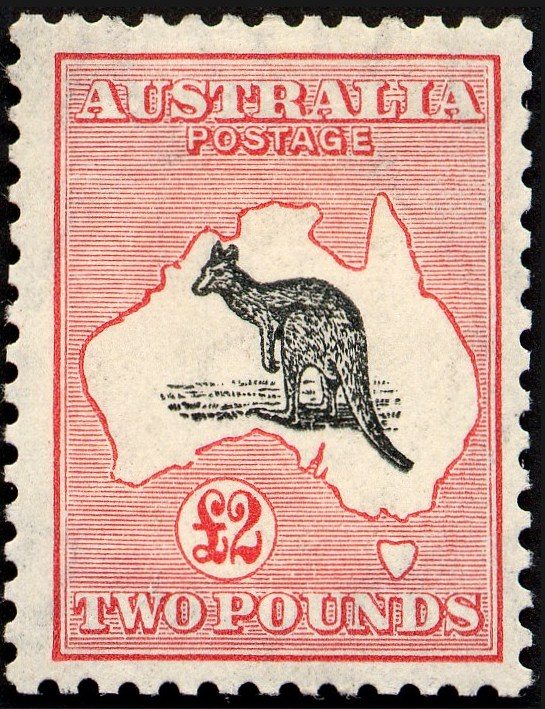
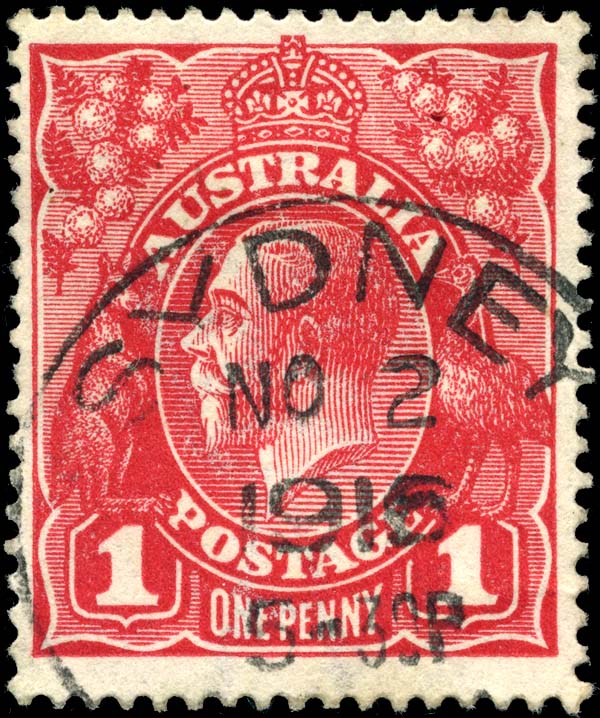
The 1913 £2 stamp in the Kangaroo and Map series. 1d King George V, used at Sydney in 1916
In 1948, H. Dormer Legge published the first definitive study of these stamps, The Kangaroo Issues of the stamps of the Commonwealth of Australia.
Australia's first commemorative stamp was issued on 9 May 1927 to mark the opening of the first Parliament House in Canberra. Subsequently, issues have appeared regularly commemorating Australian achievements and landmarks in Australian history. The first Australian multicoloured stamps appeared on 31 October 1956 as part of the Melbourne Olympic Games commemorative issue. These were printed by a foreign company. The first Australian-printed multicoloured stamp, commemorating the 50th anniversary of the Australian Inland Mission, was issued on 5 September 1962.
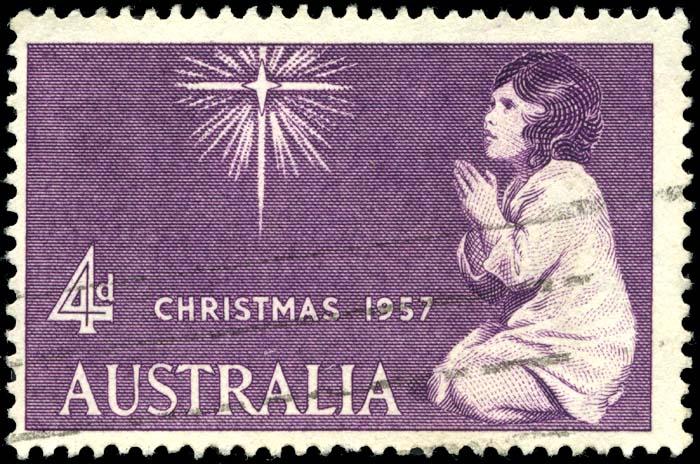
1957 Christmas stamp
There have been many special issues. The first Christmas stamp appeared on 6 November 1957. In recent years, designs for the Christmas issue have alternated each year between the religious and the secular. From 1993, in October of every year, Australia Post has commemorated Stamp Collecting month with special issues, typically featuring topics that are of interest to children such as pets, native fauna and space. Commencing with the 2000 Sydney Olympic Games, during the Summer and Winter Olympic Games, stamps featuring Australians who have won an Olympic gold medal are issued on the next postal business day after the achievement.
Philately information from Wikipedia.